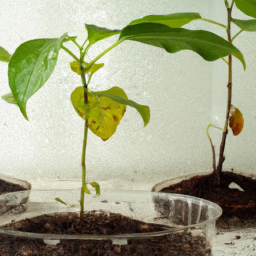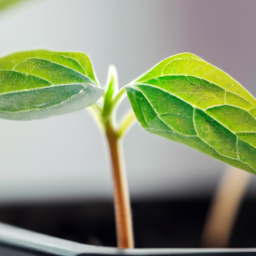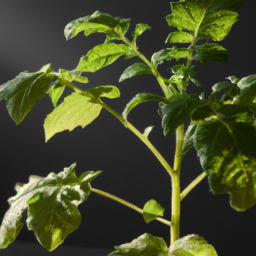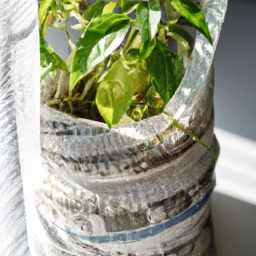
Do you dream of having a thriving indoor garden, filled with lush greenery and bountiful harvests? If so, then you’re in the right place! In this blog post, we will be unveiling the magic of grow lights and how they can transform your indoor gardening experience. Whether you’re a seasoned plant enthusiast or just starting out, understanding the power of grow lights is essential to creating a flourishing oasis right in your own home. So, let’s dive in and discover the secrets behind thriving indoor gardens and the role that grow lights play in making them a reality.
The Importance of Grow Lights in Indoor Gardening
Indoor gardening has gained immense popularity in recent years, allowing plant enthusiasts to cultivate a wide variety of plants within the comfort of their own homes. One of the key factors that contribute to the success of indoor gardens is the proper utilization of grow lights.
Understanding the Role of Grow Lights
Grow lights serve as an artificial light source that replicates the natural sunlight required for plant growth. Since indoor gardens lack access to direct sunlight, grow lights become essential to provide plants with the necessary light spectrum for photosynthesis.
Plants rely on different wavelengths of light for various stages of growth. Grow lights are designed to emit specific light spectrums, including red, blue, and white, which are crucial for plant development. Red light promotes flowering and fruiting, while blue light stimulates vegetative growth. White light, on the other hand, mimics natural sunlight and is beneficial for overall plant health.
By strategically placing grow lights above plants, gardeners can ensure that their indoor garden receives the optimal amount and quality of light required for healthy growth. This is especially important in spaces with limited natural light, such as basements or rooms with small windows.
The Benefits of Using Grow Lights
1. Extended Growing Season: With the use of grow lights, indoor gardeners can extend the growing season throughout the year. This means that you can enjoy fresh herbs, vegetables, and flowers even during the winter months when outdoor gardening is not possible.
2. Greater Control: Grow lights give gardeners greater control over the light intensity and duration, allowing them to customize the lighting conditions for different plant species. This control is particularly advantageous for delicate plants that require specific light requirements.
3. Faster Growth and Higher Yields: When plants receive the right amount of light, they tend to grow faster and produce higher yields. Grow lights can accelerate plant growth by providing consistent and optimal lighting conditions, resulting in healthier and more productive indoor gardens.
Choosing the Right Grow Lights
When selecting grow lights for your indoor garden, there are a few factors to consider:
1. Light Spectrum: Different plants have varying light requirements. Ensure that the grow lights you choose emit the appropriate spectrum of light for the specific plants you are growing.
2. Light Intensity: The intensity of the light emitted by grow lights is measured in lumens or lux. Consider the light requirements of your plants and choose lights with sufficient intensity to meet their needs.
3. Energy Efficiency: Opt for energy-efficient grow lights to minimize electricity consumption and reduce your carbon footprint. LED grow lights are a popular choice due to their efficiency and long lifespan.
4. Heat Output: Some types of grow lights, such as traditional incandescent bulbs, can generate excessive heat. This can be detrimental to plants, so it’s important to choose lights that emit minimal heat or invest in proper ventilation systems.
By carefully considering these factors, you can select the most suitable grow lights for your indoor garden and ensure optimal plant growth.
In conclusion, grow lights play a crucial role in indoor gardening by providing the necessary light spectrum for photosynthesis. They allow gardeners to extend the growing season, have greater control over lighting conditions, and promote faster growth and higher yields. By choosing the right grow lights, indoor gardeners can create thriving indoor gardens that are a delight to behold.

Choosing the Right Grow Lights for Your Indoor Garden
Welcome to the world of indoor gardening! Whether you are a seasoned gardener or just starting out, understanding the magic of grow lights is essential for the success of your indoor garden. In this guide, we will help you choose the right grow lights that will help your plants thrive.
Understanding the Different Types of Grow Lights
Before diving into the details of choosing the right grow lights, let’s familiarize ourselves with the different types available in the market:
1. Fluorescent Grow Lights: Fluorescent lights are popular among indoor gardeners due to their affordability and versatility. They come in two main types: compact fluorescent lights (CFLs) and high-output fluorescent (HOFL) lights. CFLs are suitable for small indoor gardens or seedlings, while HOFL lights provide higher intensity and are ideal for larger plants.
2. LED Grow Lights: LED lights have gained popularity in recent years due to their energy efficiency and customizable spectrum. They emit less heat, making them suitable for plants that require lower temperatures. LED lights are available in various colors, allowing you to tailor the light spectrum to your plants’ specific needs.
3. High-Intensity Discharge (HID) Grow Lights: HID lights are known for their high intensity and are commonly used in commercial indoor gardens. They consist of two main types: metal halide (MH) lights and high-pressure sodium (HPS) lights. MH lights emit a bluish light spectrum, which promotes vegetative growth, while HPS lights emit a reddish spectrum, ideal for flowering and fruiting stages.
Factors to Consider When Choosing Grow Lights
Now that we have a basic understanding of the different types of grow lights, let’s explore the factors you should consider before making a purchase:
1. Light Intensity: Different plants have different light intensity requirements. Leafy greens, such as lettuce and spinach, thrive under lower light intensities, while fruiting plants, like tomatoes and peppers, require higher intensities. Consider the specific needs of your plants and choose grow lights accordingly.
2. Light Spectrum: The light spectrum plays a crucial role in plant growth and development. Blue light promotes vegetative growth, while red light stimulates flowering and fruiting. Some plants may require a specific light spectrum at different stages of growth. LED lights allow you to customize the spectrum, making them a popular choice among indoor gardeners.
3. Energy Efficiency: Indoor gardening requires a significant amount of energy to power the grow lights. Opt for energy-efficient lights, such as LED or HOFL lights, to minimize electricity costs and reduce your carbon footprint.
Choosing the Right Grow Lights for Your Indoor Garden
Now that you have a better understanding of the different types of grow lights and the factors to consider, let’s dive into choosing the right grow lights for your indoor garden:
1. Assess Your Garden’s Needs: Start by assessing the size of your indoor garden and the types of plants you plan to grow. Determine the light intensity and spectrum requirements for your plants based on their specific needs.
2. Consider Your Budget: Different types of grow lights come with varying price tags. Set a budget that suits your requirements and explore options within that range. Remember to consider long-term costs, such as energy consumption and bulb replacement.
3. Research and Compare: Take the time to research different brands and models of grow lights. Read customer reviews and compare features, such as light intensity, spectrum customization, and energy efficiency. Look for reputable brands that offer warranties and reliable customer support.
4. Seek Expert Advice: If you are unsure about which grow lights to choose, don’t hesitate to seek advice from experienced indoor gardeners or professionals at your local gardening store. They can provide valuable insights and help you make an informed decision.
5. Set Up and Monitor: Once you have chosen the right grow lights, follow the manufacturer’s instructions for installation. Place the lights at an appropriate distance from your plants to ensure optimal light distribution. Regularly monitor your plants’ growth and adjust the light settings if necessary.
By following these steps and choosing the right grow lights for your indoor garden, you are on your way to creating a thriving oasis of greenery right in your own home. Happy gardening!

Tips and Techniques for Maximizing Plant Growth with Grow Lights
Indoor gardening has gained immense popularity in recent years, allowing plant enthusiasts to create thriving gardens within the comfort of their homes. One crucial element that plays a significant role in the success of indoor gardens is the use of grow lights. These artificial light sources simulate the natural sunlight required for plant growth, enabling plants to flourish even in spaces with limited access to sunlight. In this article, we will delve into the tips and techniques for maximizing plant growth with grow lights, unraveling the magic they bring to indoor gardening.
Choosing the Right Grow Lights
The first step in maximizing plant growth with grow lights is selecting the right type of lights for your indoor garden. There are various options available, each with its own set of advantages and considerations. Here are a few popular types:
1. Fluorescent Grow Lights: Fluorescent lights are a cost-effective option, making them ideal for beginners. They emit a broad spectrum of light suitable for most plants and are available in two types: compact fluorescent lights (CFLs) and high-output fluorescent lights (HOFLs). CFLs are energy-efficient and suitable for small-scale gardens, while HOFLs provide higher light intensity, making them suitable for larger gardens.
2. LED Grow Lights: LED lights are highly energy-efficient and have a longer lifespan compared to other options. They come in various spectrums, allowing you to customize the light according to your plants’ specific needs. LED lights also produce less heat, reducing the risk of burning your plants.
3. High-Intensity Discharge (HID) Lights: HID lights are the most powerful grow lights available. They are commonly used in commercial settings or large-scale indoor gardens. There are two types of HID lights: metal halide (MH) lights, which provide a bluish light spectrum suitable for vegetative growth, and high-pressure sodium (HPS) lights, which emit a reddish spectrum ideal for flowering and fruiting stages.
Consider the size of your indoor garden, the specific light requirements of your plants, and your budget when choosing the right grow lights for optimal plant growth.
Placement of Grow Lights
Once you have chosen the appropriate grow lights, their placement plays a crucial role in maximizing plant growth. Here are some tips for proper placement:
1. Adjust the Height: The distance between the plants and the grow lights should be adjustable. As a general rule, maintain a distance of 12 to 24 inches between the plants and the lights. However, different plants may have varying light requirements, so it’s essential to monitor their growth and adjust the height accordingly.
2. Positioning for Uniform Coverage: To ensure uniform growth, position the grow lights in a way that provides equal coverage to all plants. Consider using reflective materials or light hoods to redirect and maximize the light reaching the plants.
3. Avoid Heat Buildup: Some grow lights emit heat, which can potentially harm your plants. Make sure to provide adequate ventilation and airflow to prevent heat buildup. Consider using fans or other cooling mechanisms to maintain an optimal temperature for your plants.
Lighting Schedule and Duration
Establishing the right lighting schedule and duration is vital for the health and growth of your indoor garden. Here are some guidelines:
1. Determine the Light Requirements: Different plants have varying light requirements. Some may thrive with 12 to 16 hours of light per day, while others may require up to 18 hours. Research the specific light needs of your plants and create a lighting schedule accordingly.
2. Mimic Natural Sunlight: To simulate natural sunlight, consider using timers to automate the lighting schedule. Mimicking the day-night cycle ensures your plants receive the necessary rest period for optimal growth.
3. Monitor Plant Response: Keep a close eye on your plants’ response to the lighting schedule. If you notice signs of stress, such as wilting or yellowing leaves, adjust the duration or intensity of the light accordingly. Regularly observing your plants will help you fine-tune the lighting schedule for maximum growth.
By following these tips and techniques, you can harness the magic of grow lights to create a thriving indoor garden. Remember to choose the right type of grow lights, position them correctly, and establish an appropriate lighting schedule. With proper care and attention, your indoor plants will flourish, adding beauty and freshness to your living space.
Key Takeaways
Indoor gardening has become increasingly popular, allowing plant enthusiasts to create lush green spaces even in the smallest of apartments. But what’s the secret behind these thriving indoor gardens? It’s all about the magic of grow lights! These artificial light sources have revolutionized the way we grow plants indoors, providing the necessary light spectrum for photosynthesis and ensuring healthy growth year-round.
Grow lights are designed to mimic the natural sunlight that plants need to thrive. They emit a specific light spectrum, including red and blue wavelengths, which are essential for plant growth. By using grow lights, indoor gardeners can provide their plants with the perfect amount and intensity of light, regardless of the weather or limited natural light availability. This means that you can finally grow your favorite herbs, flowers, or even vegetables indoors, no matter the season.
The benefits of grow lights extend beyond just providing light for plants. They also allow for greater control over the growth process. By adjusting the light intensity and duration, indoor gardeners can manipulate the growth rate, flowering, and fruiting of their plants. This level of control is especially useful for those who want to experiment with different plant varieties or have specific gardening goals. Additionally, grow lights are energy-efficient and long-lasting, making them a sustainable choice for indoor gardening.
So, if you’ve been dreaming of having a thriving indoor garden, it’s time to unveil the magic of grow lights. With these artificial light sources, you can transform any space into a green oasis and enjoy the benefits of gardening all year round.
Here are the top questions that we were asked:
Q1: What are grow lights and why are they important for indoor gardens?
A1: Grow lights are artificial light sources designed to provide the necessary spectrum of light for plants to grow indoors. They are important for indoor gardens because they mimic natural sunlight, which is crucial for photosynthesis and the overall growth and development of plants. Without sufficient light, plants may become weak, spindly, or fail to produce flowers or fruits.
Q2: What types of grow lights are available for indoor gardening?
A2: There are several types of grow lights available, including fluorescent, LED, and high-intensity discharge (HID) lights. Fluorescent lights are affordable and energy-efficient, making them suitable for small-scale indoor gardens. LED lights are highly versatile, long-lasting, and energy-efficient, allowing for precise control over light spectrum. HID lights, such as metal halide and high-pressure sodium lights, are powerful and effective for larger indoor gardens.
Q3: How do I choose the right grow light for my indoor garden?
A3: When choosing a grow light, consider factors such as the size of your indoor garden, the type of plants you want to grow, and your budget. Determine the light intensity and spectrum requirements of your plants, as different species have varying light needs. Assess the available space for installation and the energy efficiency of the grow light to optimize your indoor gardening experience.
Q4: How far should grow lights be placed from plants?
A4: The distance between grow lights and plants depends on the type of light and the growth stage of the plants. Generally, fluorescent lights should be placed 6-12 inches above the plants, while LED lights can be positioned 12-24 inches away. HID lights require more distance, usually 24-48 inches, to prevent heat damage. Always refer to the manufacturer’s guidelines for specific recommendations to ensure optimal growth and avoid light burn.
Q5: Can I use grow lights as the sole source of light for my indoor garden?
A5: Yes, it is possible to use grow lights as the sole source of light for your indoor garden. However, it is essential to provide the correct light spectrum and intensity required for healthy plant growth. Additionally, consider incorporating natural light if available, as it provides a more balanced spectrum. Using a combination of grow lights and natural light can enhance the overall health and productivity of your indoor garden.
Dr. Olivia Green is a botanist with over two decades of experience in indoor plant cultivation. She holds a Ph.D. in Plant Biology and has dedicated her career to researching plant behavior in controlled environments. Dr. Green is passionate about helping plant enthusiasts master the art of indoor gardening through her extensive knowledge and practical insights.


